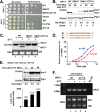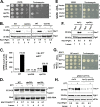Vps34 and TOR Kinases Coordinate HAC1 mRNA Translation in the Presence or Absence of Ire1-Dependent Splicing
- PMID: 33972394
- PMCID: PMC8224233
- DOI: 10.1128/MCB.00662-20
Vps34 and TOR Kinases Coordinate HAC1 mRNA Translation in the Presence or Absence of Ire1-Dependent Splicing
Abstract
In the budding yeast Saccharomyces cerevisiae, an mRNA, called HAC1, exists in a translationally repressed form in the cytoplasm. Under conditions of cellular stress, such as when unfolded proteins accumulate inside the endoplasmic reticulum (ER), an RNase Ire1 removes an intervening sequence (intron) from the HAC1 mRNA by nonconventional cytosolic splicing. Removal of the intron results in translational derepression of HAC1 mRNA and production of a transcription factor that activates expression of many enzymes and chaperones to increase the protein-folding capacity of the cell. Here, we show that Ire1-mediated RNA cleavage requires Watson-Crick base pairs in two RNA hairpins, which are located at the HAC1 mRNA exon-intron junctions. Then, we show that the translational derepression of HAC1 mRNA can occur independent of cytosolic splicing. These results are obtained from HAC1 variants that translated an active Hac1 protein from the unspliced mRNA. Additionally, we show that the phosphatidylinositol-3-kinase Vps34 and the nutrient-sensing kinases TOR and GCN2 are key regulators of HAC1 mRNA translation and consequently the ER stress responses. Collectively, our data suggest that the cytosolic splicing and the translational derepression of HAC1 mRNA are coordinated by unique and parallel networks of signaling pathways.
Keywords: ER; Gcn2; Hac1; Ire1; TOR; UPR; Vps34; translation.
Figures








Similar articles
-
Messenger RNA targeting to endoplasmic reticulum stress signalling sites.Nature. 2009 Feb 5;457(7230):736-40. doi: 10.1038/nature07641. Epub 2008 Dec 14. Nature. 2009. PMID: 19079237 Free PMC article.
-
Specificity in endoplasmic reticulum-stress signaling in yeast entails a step-wise engagement of HAC1 mRNA to clusters of the stress sensor Ire1.Elife. 2014 Dec 30;3:e05031. doi: 10.7554/eLife.05031. Elife. 2014. PMID: 25549299 Free PMC article.
-
Ribosome depurination by ricin leads to inhibition of endoplasmic reticulum stress-induced HAC1 mRNA splicing on the ribosome.J Biol Chem. 2019 Nov 22;294(47):17848-17862. doi: 10.1074/jbc.RA119.009128. Epub 2019 Oct 17. J Biol Chem. 2019. PMID: 31624149 Free PMC article.
-
Translation Control of HAC1 by Regulation of Splicing in Saccharomyces cerevisiae.Int J Mol Sci. 2019 Jun 12;20(12):2860. doi: 10.3390/ijms20122860. Int J Mol Sci. 2019. PMID: 31212749 Free PMC article. Review.
-
The unfolded protein response: the dawn of a new field.Proc Jpn Acad Ser B Phys Biol Sci. 2015;91(9):469-80. doi: 10.2183/pjab.91.469. Proc Jpn Acad Ser B Phys Biol Sci. 2015. PMID: 26560836 Free PMC article. Review.
Cited by
-
The Central FacilitaTOR: Coordinating Transcription and Translation in Eukaryotes.Int J Mol Sci. 2025 Mar 21;26(7):2845. doi: 10.3390/ijms26072845. Int J Mol Sci. 2025. PMID: 40243440 Free PMC article. Review.
-
Induction of the Unfolded Protein Response at High Temperature in Saccharomyces cerevisiae.Int J Mol Sci. 2022 Jan 31;23(3):1669. doi: 10.3390/ijms23031669. Int J Mol Sci. 2022. PMID: 35163590 Free PMC article.
-
Fundamental and Applicative Aspects of the Unfolded Protein Response in Yeasts.J Fungi (Basel). 2023 Oct 5;9(10):989. doi: 10.3390/jof9100989. J Fungi (Basel). 2023. PMID: 37888245 Free PMC article. Review.
References
Publication types
MeSH terms
Substances
Grants and funding
LinkOut - more resources
Full Text Sources
Other Literature Sources
Molecular Biology Databases
